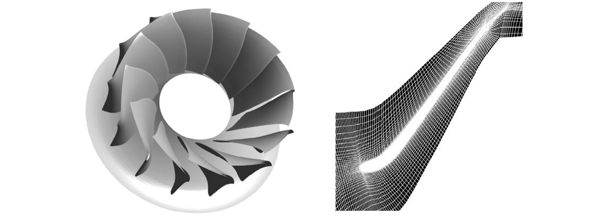The hydraulic design of Francis turbine runners requires the accomplishment of several targets and constraints. A
high level of efficiency and a cavitation-free flow in the runner is usually desirable.
The flow in Francis turbine runners is highly rotational and three-dimensional, and therefore only three-dimensional methods will provide an effective solution for a Francis runner. A considerable improvement in the design of Francis turbines has been obtained by the use of Computational Fluid Dynamics (CFD). CFD results provide a better understanding of flow physics, and they are now commonly used in industry.
Although these methods are very useful for analysis in different design configurations, they cannot be directly used as a design tool as they do not provide direct information on how to change the runner shape. So, the designer must rely on trial and error to improve the runner geometry. With its reliance on empiricism, such an approach may restrict the part of the design space that is being used in the design as the designer tends to stay within the bounds of successful previous designs.

A major improvement in the design of Francis runners can be achieved by the application of the 3D inverse design method for the design of the runner shapes. Unlike conventional direct design methods, where the blade geometry is described by geometrical parameters, the inverse design uses hydrodynamic parameters like the blade loading, to compute the blade shape, offering a major advantage in the design process.
Such an approach allows designers to directly relate their understanding of flow physics in the design process and hence access a larger part of the design space.
The application of the 3D inverse design method has already resulted in important design breakthroughs such as suppression of secondary flows in radial and mixed flow impeller impellers, improvement of suction performance and efficiency of water jet pumps, suppression of corner separation in pump diffusers and improvement of cavitation in a Francis turbine runner.
In the publication 'Parametric Design of a Francis Turbine Runner', written by K. Daneshkah and M. Zangeneh, a parametric design study of a Francis turbine runner is carried out where an inverse design method is used to describe the runner geometry, and CFD analyses parametrically are performed to evaluate the hydrodynamic and suction performance of different configurations.
First, a baseline design was created using the basic design specifications of the Francis turbine runner.
Next, the impact of stacking conditions on the runner's performance was assessed. The aim of this study was to understand the effect of stacking conditions on the runner's efficiency and suction performance.
Then, the effect of blade loading was studied for an optimum stacking configuration obtained in the previous step to achieve a cavitation-free flow in the runner while maintaining a high level of hydraulic efficiency.
Mehrdad Zangeneh
Mehrdad Zangeneh is Founder and Managing Director of Advanced Design Technology and professor of Thermofluids at University College London.
View All Articles






Share This Post